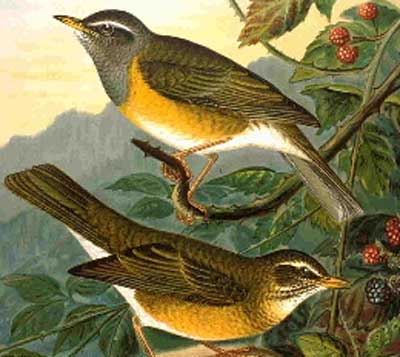
Turdus obscurus (*)
Superregnum: Eukaryota
Regnum: Animalia
Subregnum: Eumetazoa
Cladus: Bilateria
Cladus: Nephrozoa
Superphylum: Deuterostomia
Phylum: Chordata
Subphylum: Vertebrata
Infraphylum: Gnathostomata
Megaclassis: Osteichthyes
Cladus: Sarcopterygii
Cladus: Rhipidistia
Cladus: Tetrapodomorpha
Cladus: Eotetrapodiformes
Cladus: Elpistostegalia
Superclassis: Tetrapoda
Cladus: Reptiliomorpha
Cladus: Amniota
Classis: Reptilia
Cladus: Eureptilia
Cladus: Romeriida
Subclassis: Diapsida
Cladus: Sauria
Infraclassis: Archosauromorpha
Cladus: Crurotarsi
Divisio: Archosauria
Cladus: Avemetatarsalia
Cladus: Ornithodira
Subtaxon: Dinosauromorpha
Cladus: Dinosauriformes
Cladus: Dracohors
Cladus: Dinosauria
Ordo: Saurischia
Cladus: Eusaurischia
Cladus: Theropoda
Cladus: Neotheropoda
Cladus: Averostra
Cladus: Tetanurae
Cladus: Avetheropoda
Cladus: Coelurosauria
Cladus: Tyrannoraptora
Cladus: Maniraptoromorpha
Cladus: Maniraptoriformes
Cladus: Maniraptora
Cladus: Pennaraptora
Cladus: Paraves
Cladus: Eumaniraptora
Cladus: Avialae
Infraclassis: Aves
Cladus: Euavialae
Cladus: Avebrevicauda
Cladus: Pygostylia
Cladus: Ornithothoraces
Cladus: Euornithes
Cladus: Ornithuromorpha
Cladus: Ornithurae
Cladus: Carinatae
Parvclassis: Neornithes
Cohors: Neognathae
Cladus: Neoaves
Cladus: Telluraves
Cladus: Australaves
Ordo: Passeriformes
Subordo: Passeri
Infraordo: Passerida
Superfamilia: Muscicapoidea
Familia: Turdidae
Genus: Turdus
Species: Turdus obscurus
Name
Turdus obscurus Gmelin, 1789
Vernacular names
日本語: マミチャジナイ
スズメ目ヒタキ科
References
Systema Naturae 1 pt2 p. 816
The eyebrowed thrush (Turdus obscurus) is a member of the thrush family Turdidae. The scientific name comes from Latin Turdus, "thrush" and obscurus "dark".[2]
Egg, Collection Museum Wiesbaden
It breeds in dense coniferous forest and taiga eastwards from Siberia and Mongolia to Japan. It is strongly migratory, wintering south to China and Southeast Asia. It is a rare vagrant to western Europe.
It nests in trees, laying 4-6 eggs in a neat nest. Migrating birds and wintering birds often form small flocks. It is omnivorous, eating a wide range of insects, earthworms and berries.
From Khonoma village in Nagaland, India.
This is an attractive thrush, with a grey back and head, the latter having a black eyeline, bordered white above and below. The breast and flanks are orange, and the belly white. The sexes are fairly similar, but immatures have a browner back.
The male has a simple whistling song, similar to the related mistle thrush.
In 2007 an eyebrowed thrush was sighted at the Jerusalem Bird Observatory in Jerusalem.[3] This is the second recorded sighting in Israel; the first was at Eilat in October 1996.
In 2011, an eyebrowed thrush was sighted in Australia, near Malanda in Queensland.[4] This is possibly the first confirmed sighting of the species on the Australian mainland.
Fossil record
In 2017, an assessment of late Pleistocene Indonesian passerines found a fossil of this species.[5]
References
BirdLife International (2016). "Turdus obscurus". IUCN Red List of Threatened Species. 2016: e.T22708793A94177211. doi:10.2305/IUCN.UK.2016-3.RLTS.T22708793A94177211.en. Retrieved 12 November 2021.
Jobling, James A (2010). The Helm Dictionary of Scientific Bird Names. London: Christopher Helm. pp. 278, 393. ISBN 978-1-4081-2501-4.
Jacobs, Megan (5 November 2007). "Rare bird is sighted in Jerusalem". Jerusalem Post. Retrieved 4 October 2017.
"Eye-browed Thrush – First for Australia, Feb. 9, 2011, Bird-o.com". Archived from the original on 2012-07-08. Retrieved 2011-12-08.
Meijer, Hanneke J.M.; Awe Due, Rokus; Sutikna, Thomas; Saptomo, Wahyu; Jatmiko; Wasisto, Sri; Tocheri, Matthew W.; Mayr, Gerald (2017-08-17). "Late Pleistocene songbirds of Liang Bua (Flores, Indonesia); the first fossil passerine fauna described from Wallacea". PeerJ. 5: e3676. doi:10.7717/peerj.3676. PMC 5563437. PMID 28828271.
Retrieved from "http://en.wikipedia.org/"
All text is available under the terms of the GNU Free Documentation License

